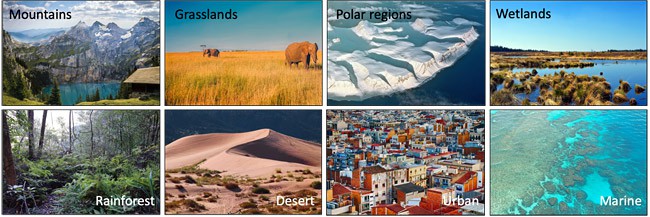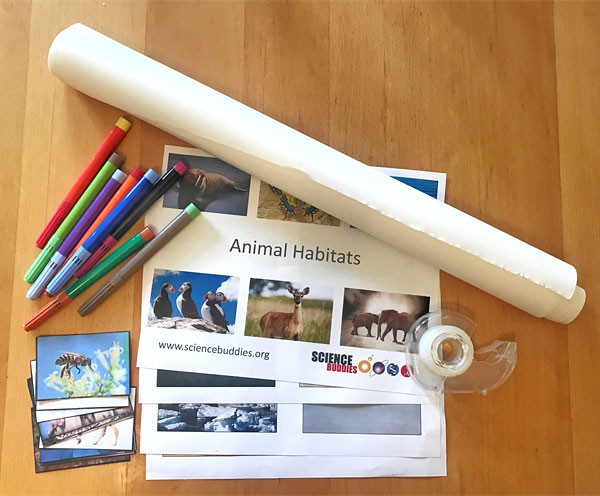Summary

Overview
In this lesson, students play a game. Each classroom corner represents a habitat. After selecting an animal card, students have to move to the matching habitat while acting out the animal displayed on their card. By explaining why they selected a certain habitat, students realize that a habitat is a place that helps an animal survive.
Learning Objectives
- Describe at least three different habitats.
- List a variety of animals that live in a certain habitat.
- Give examples of how a habitat meets the needs of an animal living there.
NGSS Alignment
This lesson helps students prepare for these Next Generation Science Standards Performance Expectations:- K-ESS3-1. Use a model to represent the relationship between the needs of different plants and animals (including humans) and the places they live.
- 2-LS4-1. Make observations of plants and animals to compare the diversity of life in different habitats.
|
Science & Engineering Practices
Analyzing and Interpreting Data.
Use observations (firsthand or from media) to describe patterns and/or relationships in the natural and designed world(s) in order to answer scientific questions and solve problems.
Engaging in Argument from Evidence. Construct an argument with evidence to support a claim. |
Disciplinary Core Ideas
ESS3.A: Natural Resources.
Living things need water, air, and resources from the land, and they live in places that have the things they need. Humans use natural resources for everything they do.
LS4.D: Biodiversity and Humans. There are many different kinds of living things in any area, and they exist in different places on land and in water. |
Crosscutting Concepts
Patterns.
Patterns in the natural and human designed world can be observed and used as evidence.
|
Materials
 Image Credit: Svenja Lohner, Science Buddies / Science Buddies
Image Credit: Svenja Lohner, Science Buddies / Science Buddies
- Printed and cut animal cards
- Printed example habitats
- Poster paper (4 sheets)
- Markers
- Tape or push pins
Background Information for Teachers
This section contains a quick review for teachers of the science and concepts covered in this lesson.There are millions of different species (or groups of living organisms) on our planet. These include animals as well as plants. Some of these species, like us humans and many other mammals, like to live on land. Other species, such as fish, prefer to live in the water. Every species likes to settle in areas that provide access to food and water for them. This particular environmental area is called a species' habitat. A habitat is the natural home of a specific animal or plant species. Animals or plant species live in a particular habitat because this environment provides them with everything they need to survive, grow, and reproduce. This means a species' habitat is the place where it can find food, water, air, and protection.
Habitats can be described using many factors. Some of these factors are of physical characteristics such as climate, soil type, amount of rainfall, sun exposure, light, etc. Other factors are biological and include the availability of food in form of plants or animals, as well as the presence or absence of predators. Different species have different habitat requirements. Whereas some plants or animals are generalists, which can easily adapt and live in a wide range of habitats, others are specialists, that can only thrive in one specific type of environment.
 Image Credit: Svenja Lohner, Science Buddies / Science Buddies
Image Credit: Svenja Lohner, Science Buddies / Science Buddies
Figure 1. Examples of different habitats.
There are many different habitats around the world (Figure 1). Some examples of terrestrial habitats are forests, grasslands, deserts or wetlands while freshwater habitats include lakes, ponds or rivers. Marine habitats include the oceans, reefs, and estuaries, and the polar habitats are in the polar regions.
Habitats are constantly changing either due to natural processes such as droughts, fires, earthquakes, and disease, or due to human activities such as building cities, dams, or pollution. Habitat change or destruction can be a serious issue for many animal and plant species living there. Whereas some species can benefit from habitat changes, others suffer or even die out. Yet other species are able to adapt to the changes in their habitats and can cope with their new environment.
Habitats can be very fragile so that even small changes can have big effects. Corals for example live in the shallow waters of an ocean, which is their habitat. They have adapted to specific water conditions. If you change the water quality, for example, by making it more acidic, the corals die. This in turn has effects on the fish that live in the coral reef habitat. They can no longer hide between the corals and thus lose their protection from predators. The loss of habitats due to major habitat changes or destruction is a major cause of species extinction and poses a great threat to many animals and plants alike. This is why it is important to protect natural habitats and the animals and plants that live in these special environments.
In this lesson, students will have to assign a specific animal to its correct habitat. Each classroom corner represents one habitat. After selecting an animal card, students will have to move to the habitat while acting out the animal displayed on their card. As they explain why they moved into a certain habitat, students will realize that a habitat is a place that helps an animal to survive by meeting its specific needs.



